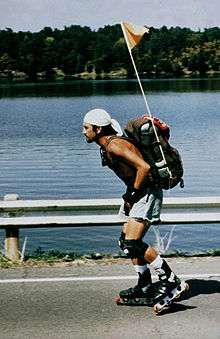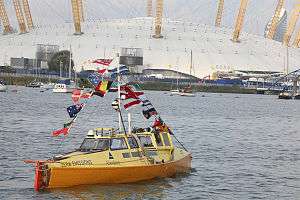Expedition 360
Expedition 360 is the name of a successful attempt by Briton Jason Lewis to be the first person to circumnavigate the globe using only human power – no motors or sails.[1][2] It was begun by Lewis and Stevie Smith in 1994 and ended at 12:24 pm[3] on 6 October 2007, when Lewis re-crossed the prime meridian at Greenwich, London, having travelled 74,842 km (46,505 mi).[4][5]

Underlying definition
A true circumnavigation of the world must pass through two points antipodean to each other. Norris McWhirter, founding editor of Guinness, 1971.
[A] true circumnavigation of the Earth must: start and finish at the same point, traveling in one general direction, reach two antipodes, cross the equator, cross all longitudes, cover a minimum of 40,000km. AdventureStats by Explorersweb
History
In 2006, the Adventure publication of the National Geographic Society honored Canadians Colin Angus and Julie Wafaei as Adventurers of the Year for their "journey around the world" by human power, however, the Society stated they do not "act as an official arbiter of geographic issues".[6] Angus' journey did not cross the equator or hit the minimum of two antipodal points as stipulated by the rules of Guinness World Records or AdventureStats by Explorersweb. Additionally, in the February 2013 issue of Outside Magazine, Angus's then traveling partner Tim Harvey went on the record to say the pair "put up an emergency sail, using it for about 95 nautical miles" crossing the Bering Sea between Alaska and Siberia.[7] As journalist Nick Heil pointed out, this alone was enough to disqualify a human-powered claim of any description.
Expedition 360 conformed to the rules of adjudicating bodies Guinness World Records and AdventureStats by Explorers Web. The only other person to have completed a legitimate human-powered circumnavigation is Turkish American adventurer Erden Eruç who completed the first solo circumnavigation between July 2007 and July 2012.[8]
This unique concept of going around the world by human power first came as a wild idea to Stevie Smith as he worked in his office in Paris. He soon set about making the idea a reality and got the help of his friend Jason Lewis who agreed to come with him. The pair set about spreading the idea, and began to raise money for a pedal boat built by Chris Tipper[9] and Hugo Burnham. The specially-built boat was named Moksha, Sanskrit for freedom. To raise cash Stevie cycled to Marrakesh, Morocco. The pair had no formal training in either cycling or riding pedal boats.
The Expedition
European leg
Smith and Lewis set off on bicycles from Greenwich, London at midday on 12 July 1994. They cycled south-east across Britain to the coast at Rye, then pedalled across the English Channel, and then cycled south again across France through major cities including Paris and Orléans. The pair split up for a short while, meeting back up in Spain. They then travelled through Madrid, across Portugal and through Lisbon, finally arriving at Lagos on 29 September 1994. According to Smith, they slept outdoors, taking their sleeping bags into open places and sleeping under the stars.
The Atlantic Ocean
The trip across the Atlantic took 111 days, pedaling in two-hour day and four-hour night shifts. It ended in Miami.
North America
They crossed the North American continent on bicycles and skates. Skating near Pueblo, Colorado, Lewis was hit by a drunk driver and broke both of his legs. He spent 9 months in Colorado healing and resting.[10][11]
Pacific

Lewis completed the journey across the Pacific in the Moksha. Smith quit the project in Hawaii.
Australasia
The next leg to be completed was Australia and Indonesia. The journey north used pedal boats, kayaks and bicycle. This leg of the circumnavigation in Australia was especially noteworthy, as Jason reached the antipode to his Atlantic crossing path.
Final legs
The second half of Jason's human powered circumnavigation journey continued through Southeastern Asia and India before crossing the Arabian Sea to the African shores, from where he aimed north toward the Middle East and Europe, eventually returning to his starting point in England.
During his expedition, Lewis twice survived malaria, septicaemia, a bout of mild schizophrenia, and a crocodile attack near Australia in 2005.[12]
See also
References
- ↑ Guinness World Records (6 October 2007). "Human Powered Circumnavigations" (PDF).
- ↑ AdventureStats - by Explorersweb
- ↑ x360 Journal: Circumnavigation Complete!
- ↑ BBC NEWS | UK | Human power fuels 13-year odyssey
- ↑ BBC NEWS | England | Dorset | Briton completes 13-year odyssey
- ↑ National Geographic Adventure Magazine letter (12 June 2007). "Human Powered Circumnavigation Controversy" (PDF).
- ↑ Outside Magazine (February 2007). "Around the World in 1,026 days".
- ↑ "Guinness World Records – First solo circumnavigation of the globe using human power". Guinness World Records. Archived from the original on 19 March 2016. Retrieved 26 October 2016.
- ↑ Daily Mail article: Moksha's Last Leg Home
- ↑ x360 Journal: USA LEG by inline skates (Jason) - Ft. Lauderdale to Pueblo, Colorado. Retrieved 28 May 2016.
- ↑ Peddling to Hawaii
- ↑ Elliott, John (7 October 2007). "Back home after 13 years Jason Lewis is first man to circle world on muscle power". The Times. London. Retrieved 5 May 2010.
Further reading
- Smith, Stevie, Pedaling To Hawaii: A Human-Powered Odyssey, US: Countryman; UK Summersdale Publishers Ltd (2006) foreword by the Dalai Lama.
- Carter, Mike, "One Man and his Bike", Ebury Press (June 2, 2011). The author meets Stevie Smith on his ride around the UK, giving him pause for thought as to the reason for his own journey. Smith has left the circumnavigation and is working as a ferryman in Salcombe, Devon, UK.
- Lewis, Jason, "Dark Waters (The Expedition Trilogy, part 1): True Story of the First Human-Powered Circumnavigation of the Earth", BillyFish Books (2012).
- Lewis, Jason, "The Seed Buried Deep (The Expedition Trilogy, part 2): True Story of the First Human-Powered Circumnavigation of the Earth", BillyFish Books (publication slated for Aug 1, 2013).
- Lewis, Jason, "To the Brink (The Expedition Trilogy, part 3): True Story of the First Human-Powered Circumnavigation of the Earth", BillyFish Books (publication slated for April, 2014).
External links
- Expedition 360 home page
- The Expedition film
- iBooks feature
- Definition of human powered circumnavigation
- Angus Adventures, web site of Colin Angus.